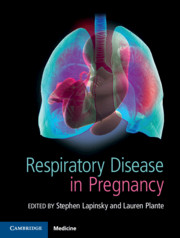28 results
Copyright page
-
- Book:
- Respiratory Disease in Pregnancy
- Published online:
- 14 April 2020
- Print publication:
- 09 April 2020, pp iv-iv
-
- Chapter
- Export citation
Section 4 - Pulmonary Conditions Related to Pregnancy
-
- Book:
- Respiratory Disease in Pregnancy
- Published online:
- 14 April 2020
- Print publication:
- 09 April 2020, pp 159-176
-
- Chapter
- Export citation

Respiratory Disease in Pregnancy
-
- Published online:
- 14 April 2020
- Print publication:
- 09 April 2020
Index
-
- Book:
- Respiratory Disease in Pregnancy
- Published online:
- 14 April 2020
- Print publication:
- 09 April 2020, pp 245-250
-
- Chapter
- Export citation
Section 5 - Other Pulmonary Issues in Pregnancy
-
- Book:
- Respiratory Disease in Pregnancy
- Published online:
- 14 April 2020
- Print publication:
- 09 April 2020, pp 177-244
-
- Chapter
- Export citation
Appendix A - Pregnancy Planning and Follow-up Guide
- from 8 - Cystic Fibrosis in Pregnancy
-
- Book:
- Respiratory Disease in Pregnancy
- Published online:
- 14 April 2020
- Print publication:
- 09 April 2020, pp 78-81
-
- Chapter
- Export citation
Section 2 - The Basics: for the Non-Obstetrician
-
- Book:
- Respiratory Disease in Pregnancy
- Published online:
- 14 April 2020
- Print publication:
- 09 April 2020, pp 25-56
-
- Chapter
- Export citation
Contributors
-
- Book:
- Respiratory Disease in Pregnancy
- Published online:
- 14 April 2020
- Print publication:
- 09 April 2020, pp vii-x
-
- Chapter
- Export citation
Section 1 - The Basics: for the Obstetrician
-
- Book:
- Respiratory Disease in Pregnancy
- Published online:
- 14 April 2020
- Print publication:
- 09 April 2020, pp 1-24
-
- Chapter
- Export citation
Section 3 - Pulmonary Conditions Not Specific to Pregnancy
-
- Book:
- Respiratory Disease in Pregnancy
- Published online:
- 14 April 2020
- Print publication:
- 09 April 2020, pp 57-158
-
- Chapter
- Export citation
Contents
-
- Book:
- Respiratory Disease in Pregnancy
- Published online:
- 14 April 2020
- Print publication:
- 09 April 2020, pp v-vi
-
- Chapter
- Export citation
Section 2 - General medical considerations
-
- Book:
- Maternal Critical Care
- Published online:
- 05 July 2013
- Print publication:
- 04 July 2013, pp 107-178
-
- Chapter
- Export citation
Chapter 13 - But what about the fetus?
- from Section 2 - General medical considerations
-
-
- Book:
- Maternal Critical Care
- Published online:
- 05 July 2013
- Print publication:
- 04 July 2013, pp 143-149
-
- Chapter
- Export citation
Maternal Critical Care - Title page
-
-
- Book:
- Maternal Critical Care
- Published online:
- 05 July 2013
- Print publication:
- 04 July 2013, pp iii-iii
-
- Chapter
- Export citation
Chapter 3 - Competency and personnel
- from Section 1 - General non-medical considerations
-
-
- Book:
- Maternal Critical Care
- Published online:
- 05 July 2013
- Print publication:
- 04 July 2013, pp 16-25
-
- Chapter
- Export citation
Chapter 21 - Monitoring the critically ill gravida
- from Section 3 - Special critical care tools and techniques
-
-
- Book:
- Maternal Critical Care
- Published online:
- 05 July 2013
- Print publication:
- 04 July 2013, pp 217-229
-
- Chapter
- Export citation
Dedication
-
- Book:
- Maternal Critical Care
- Published online:
- 05 July 2013
- Print publication:
- 04 July 2013, pp v-vi
-
- Chapter
- Export citation
Section 5 - Serious problems related to pregnancy
-
- Book:
- Maternal Critical Care
- Published online:
- 05 July 2013
- Print publication:
- 04 July 2013, pp 403-471
-
- Chapter
- Export citation
Section 1 - General non-medical considerations
-
- Book:
- Maternal Critical Care
- Published online:
- 05 July 2013
- Print publication:
- 04 July 2013, pp 1-106
-
- Chapter
- Export citation
Maternal Critical Care - Half title page
-
- Book:
- Maternal Critical Care
- Published online:
- 05 July 2013
- Print publication:
- 04 July 2013, pp i-ii
-
- Chapter
- Export citation



